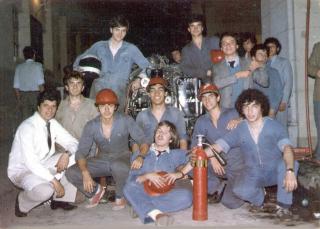 In 1983 our expectations were great, but the reality did not match with it.
G. Donvito began to work in SADE, G. Puma began to work in Río
Grande and G. Olivato entered the Military Aviation School at Córdoba. Thus our
original workgroup was dissolved. Just months later
we would have the first good news of the year: our work appeared
published in the readers' section of
Aeroespacio magazine May-Jun 1983 issue. And
months later the second good news
of the year would be that we received a donation of JP1 from the R.A.C.A.
helicopters' company located in San Fernando.
In 1983 our expectations were great, but the reality did not match with it.
G. Donvito began to work in SADE, G. Puma began to work in Río
Grande and G. Olivato entered the Military Aviation School at Córdoba. Thus our
original workgroup was dissolved. Just months later
we would have the first good news of the year: our work appeared
published in the readers' section of
Aeroespacio magazine May-Jun 1983 issue. And
months later the second good news
of the year would be that we received a donation of JP1 from the R.A.C.A.
helicopters' company located in San Fernando.
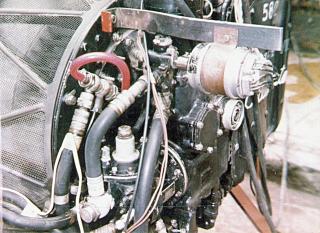 We arrived near enough the end of the regular classes period of '83 without
having been able to do much, but for the modification of the accelerator command
done again with the aid of Néstor Turró, who bought for us a pair of electric
synchronous motors that gave a much more natural sensation of the handling than
the previous mechanism.
We arrived near enough the end of the regular classes period of '83 without
having been able to do much, but for the modification of the accelerator command
done again with the aid of Néstor Turró, who bought for us a pair of electric
synchronous motors that gave a much more natural sensation of the handling than
the previous mechanism.
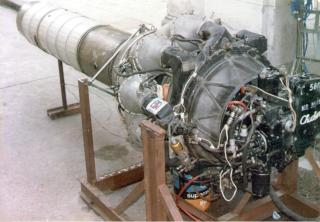 Somehow calmer than the previous year, we noticed that preparing everything
demanded much more effort than desirable. We had:
Somehow calmer than the previous year, we noticed that preparing everything
demanded much more effort than desirable. We had:
1. To move out and far the machine's 2100 lbf from the School's Engines Laboratory to its place of anchorage and to make the inverse process once finalized the tests...
2. To transport the 53 JP1 gals. of to the School's Materials Testing Laboratory roof, which gave us a run of less than 45 minutes...
3. To move the command board from the School's Electrical Measurements Laboratory and the DC generator from the School's Blacksmith workshop and to set up all the ignition system, Rumford coils included (Which had also been lent by the School's Physics' Laboratory)...
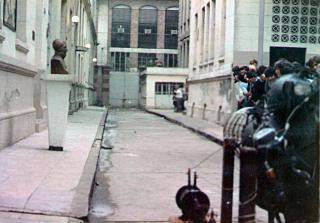 Those were not difficulties that could be characterized as insurmountable, but it
was evident that we had to rethink everything.
Those were not difficulties that could be characterized as insurmountable, but it
was evident that we had to rethink everything.
At late 1982 we thought about the construction of a stand test, so with it or not, we had to know the limit we could reach with the number of RPMs. The previous year we had arrived at 11 000 RPMs and wanted to know if we could arrive at 14 000 RPMs (take-off regime).
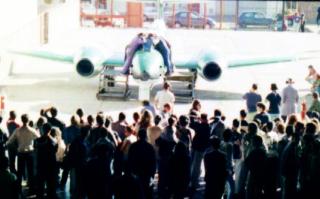 Although at first we did not realize it, counting on an internal street of almost
333 feet in length was also something not to despise. It can be seen in the photo
the E.N.E.T. N8 Jorge Newbery's Gloster Meteor Mk IV with not one, but two
Derwent V in a position not as comfortable as ours... The outside of the
Establishment is at less than 150 feet from the exhaust nozzles of both turbojets!
Although at first we did not realize it, counting on an internal street of almost
333 feet in length was also something not to despise. It can be seen in the photo
the E.N.E.T. N8 Jorge Newbery's Gloster Meteor Mk IV with not one, but two
Derwent V in a position not as comfortable as ours... The outside of the
Establishment is at less than 150 feet from the exhaust nozzles of both turbojets!
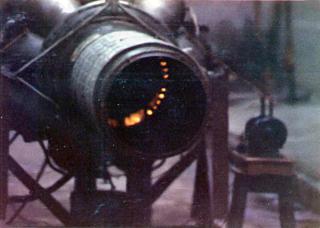 At November 15th we repeated the experiences of the previous year but we raised
the number of RPMs only up to 8 000. The news in our procedures was that due to
different obligations of the new members of the work group, it was decided to make
the tests after 07.00PM...
At November 15th we repeated the experiences of the previous year but we raised
the number of RPMs only up to 8 000. The news in our procedures was that due to
different obligations of the new members of the work group, it was decided to make
the tests after 07.00PM...
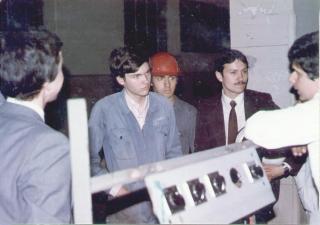 At November 17th (Technical Education's Day...) and after making some adjustments
we reached 14 000 RPMs without problems. We maintained the regime until there was
not more JP1 left. We were happy enough: we had a turbojet in excellent conditions
and noticed that working at night did not bothered us at all. We counted
with a well illuminated accessible place for the tests on the School's main yard.
At November 17th (Technical Education's Day...) and after making some adjustments
we reached 14 000 RPMs without problems. We maintained the regime until there was
not more JP1 left. We were happy enough: we had a turbojet in excellent conditions
and noticed that working at night did not bothered us at all. We counted
with a well illuminated accessible place for the tests on the School's main yard.
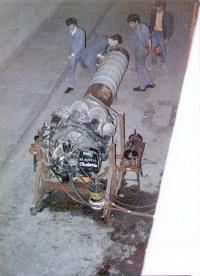 And although we were quite happy, the negative points of the experience were at
sight: we had an enormously heavy, noisy and JP1 voracious consumption turbojet
to begin to work in the project of a test stand, something what we had not exactly
in mind. Then luckyly was that Fuerza Aerea Argentina's Suboficial Mayor, Mr.
Olivato (father of G. Olivato), knowing about the retirement from service of some
Marboré II turbojets of Fuerza Aerea Argentina; paved us the way to ask for the
donation of a unit with study aims. Now we only had to wait for the answer...
that would take shape in 1987 with the arrival to the Laboratory of two units of
the IIc type. (One in supposed working conditions and other destined to cannibalizing...).
And although we were quite happy, the negative points of the experience were at
sight: we had an enormously heavy, noisy and JP1 voracious consumption turbojet
to begin to work in the project of a test stand, something what we had not exactly
in mind. Then luckyly was that Fuerza Aerea Argentina's Suboficial Mayor, Mr.
Olivato (father of G. Olivato), knowing about the retirement from service of some
Marboré II turbojets of Fuerza Aerea Argentina; paved us the way to ask for the
donation of a unit with study aims. Now we only had to wait for the answer...
that would take shape in 1987 with the arrival to the Laboratory of two units of
the IIc type. (One in supposed working conditions and other destined to cannibalizing...).
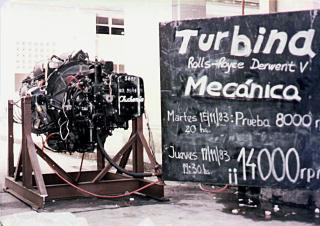 By the end of December of 1983 we journeyed the way of the School's main yard to the
School's Engines Laboratory and kept the Derwent V as it was used for the last time, in perfect
conditions. (If we can forget the "involuntary lend" of the auxiliary fuel system pump and
the thermocouple donated by Aerolineas Argentinas that would have a vital
importance years later for the starting of the Turbomeca Marboré IIc).
By the end of December of 1983 we journeyed the way of the School's main yard to the
School's Engines Laboratory and kept the Derwent V as it was used for the last time, in perfect
conditions. (If we can forget the "involuntary lend" of the auxiliary fuel system pump and
the thermocouple donated by Aerolineas Argentinas that would have a vital
importance years later for the starting of the Turbomeca Marboré IIc).
We are often asked why we did not start again the Derwent V, or why we do not do it now. We can offer several technical arguments as an answer, but we think that Derwent V and the first workgroup has already fulfilled their mission in showing the way to follow. Now it is the turn of the new generations to continue this way with the Marboré. And to improve the work done.